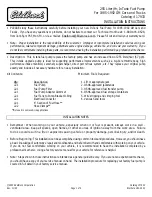
07 Wheels and tires
Glossary of tire terminology
07
174
•
Tire information placard:
A placard
showing the OE (Original Equipment) tire
sizes, recommended inflation pressure,
and the maximum weight the vehicle can
carry.
•
Tire Identification Number (TIN):
A num-
ber on the sidewall of each tire providing
information about the tire brand and man-
ufacturing plant, tire size and date of man-
ufacturer.
•
Inflation pressure:
A measure of the
amount of air in a tire.
•
Standard load:
A class of P-metric or Met-
ric tires designed to carry a maximum load
at 35 psi [37 psi (2.5 bar) for Metric tires].
Increasing the inflation pressure beyond
this pressure will not increase the tires load
carrying capability.
•
Extra load:
A class of P-metric or Metric
tires designed to carry a heavier maximum
load at 41 psi [43 psi (2.9 bar) for Metric
tires]. Increasing the inflation pressure
beyond this pressure will not increase the
tires load carrying capability.
•
kPa:
Kilopascal, a metric unit of air pres-
sure.
•
PSI:
Pounds per square inch, a standard
unit of air pressure.
•
B-pillar:
The structural member at the side
of the vehicle behind the front door.
•
Bead area of the tire:
Area of the tire next
to the rim.
•
Sidewall of the tire:
Area between the
bead area and the tread.
•
Tread area of the tire:
Area of the perim-
eter of the tire that contacts the road when
mounted on the vehicle.
•
Rim:
The metal support (wheel) for a tire or
a tire and tube assembly upon which the
tire beads are seated.
•
Maximum load rating:
a figure indicating
the maximum load in pounds and kilo-
grams that can be carried by the tire. This
rating is established by the tire manufac-
turer.
•
Maximum permissible inflation pres-
sure:
the greatest amount of air pressure
that should ever be put in the tire. This limit
is set by the tire manufacturer.
•
Recommended tire inflation pressure:
inflation pressure, established by Volvo,
which is based on the type of tires that are
mounted on a vehicle at the factory. This
inflation pressure is affected by the number
of occupants in the vehicle, the amount of
cargo, and the speed at which the vehicle
will be driven for a prolonged period. This
information can be found on the tire infla-
tion placard(s) located on the driver's side
B-pillar or on the inside of the fuel filler door
on Canadian models, and in the tire infla-
tion table in this chapter.
•
Cold tires:
The tires are considered to be
cold when they have the same temperature
as the surrounding (ambient) air. This tem-
perature is normally reached after the vehi-
cle has been parked for at least 3 hours.
Summary of Contents for 2009 XC90
Page 1: ...VOLVO XC90 Owner Manual Web Edition ...
Page 2: ......
Page 8: ...Contents 12 12 Index Index 274 ...
Page 9: ...Contents ...
Page 15: ...01 SAFETY ...
Page 49: ...01 Safety 01 ...
Page 51: ...02 INSTRUMENTS AND CONTROLS ...
Page 52: ...02 Instruments and controls Instrument overview 02 G000000 ...
Page 89: ...03 CLIMATE ...
Page 97: ...03 Climate 03 ...
Page 99: ...04 INTERIOR ...
Page 108: ...04 Interior Storage compartments 04 G033089 ...
Page 116: ...Keys and remote controls 118 Locking and unlocking 122 Child safety locks 124 Alarm 125 ...
Page 117: ...05 LOCKS AND ALARM ...
Page 127: ...06 STARTING AND DRIVING ...
Page 163: ...06 Starting and driving 06 ...
Page 165: ...07 WHEELS AND TIRES ...
Page 192: ...G020920 Washing and cleaning the vehicle 194 Paint touch up 198 ...
Page 193: ...08 CAR CARE ...
Page 199: ...08 Car care 08 ...
Page 201: ...09 MAINTENANCE AND SERVICING ...
Page 233: ...09 Maintenance and servicing 09 ...
Page 235: ...10 AUDIO ...
Page 257: ...11 SPECIFICATIONS ...
Page 258: ...11 Specifications Label information 11 G031880 G032548 ...
Page 280: ...12 Index 12 ...
Page 281: ......
Page 282: ...Kdakd 8Vg 8dgedgVi dc IE JH6 8VcVYV 6I Eg ciZY c HlZYZc iZWdg 8deng i Kdakd 8Vg 8dgedgVi dc ...
















































